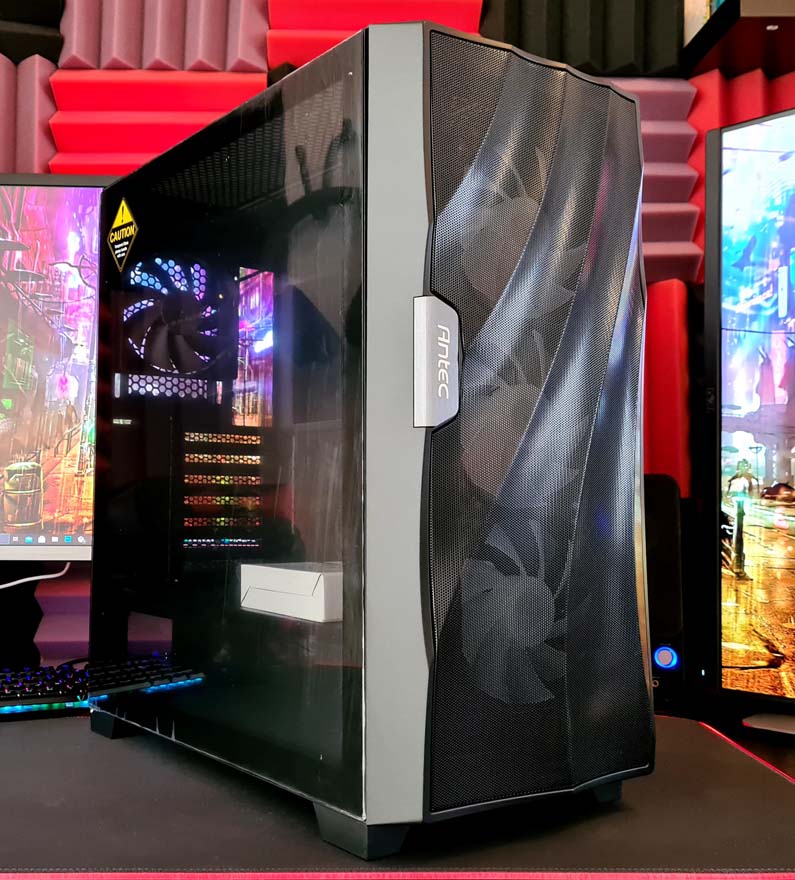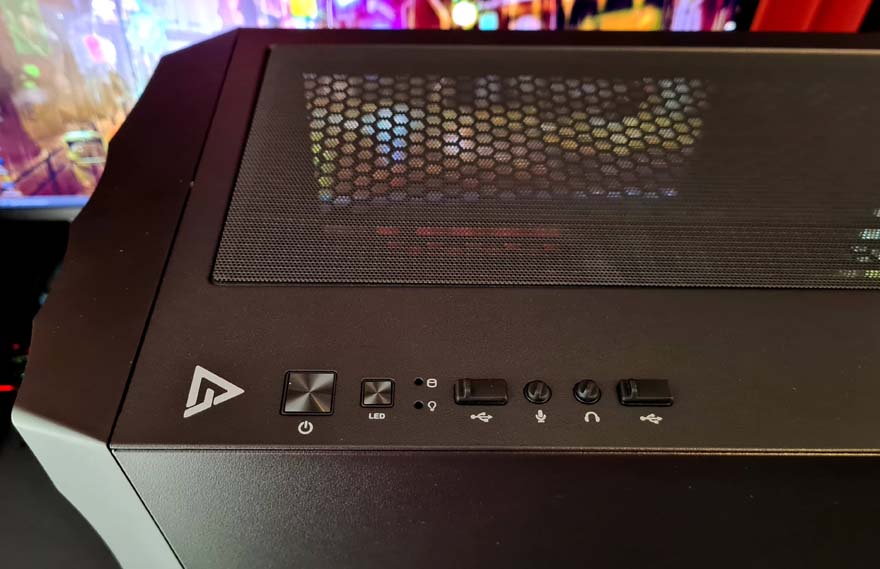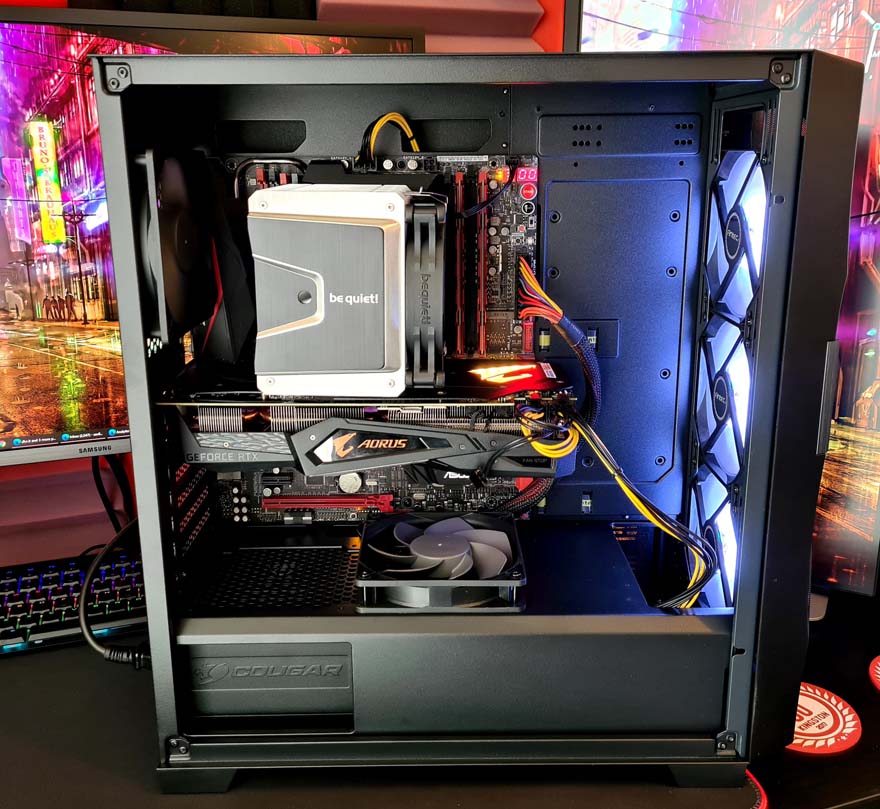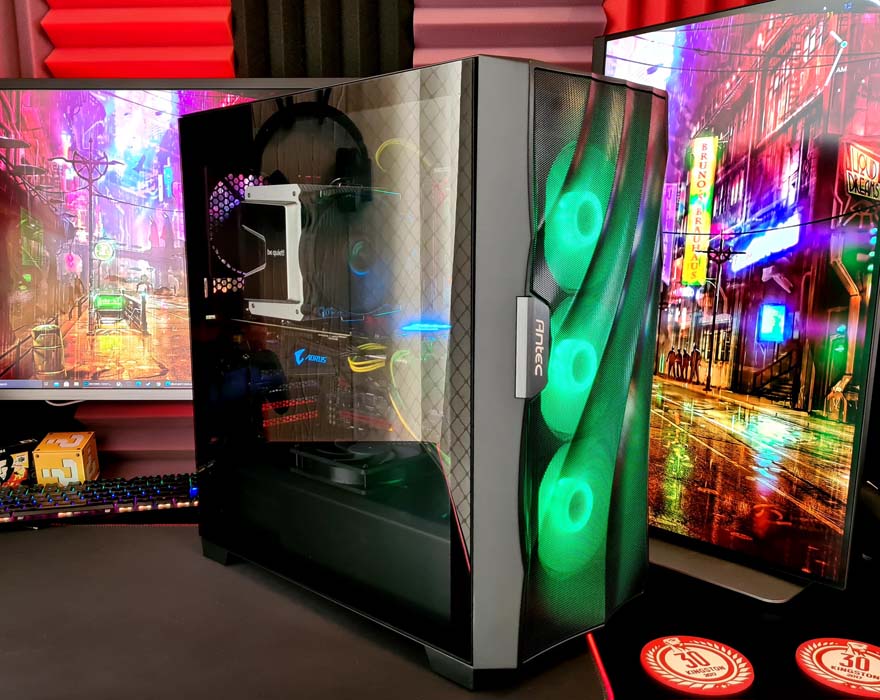Antec DF700 FLUX Case Review
Peter Donnell / 4 years ago

Antec has been making cases for longer than I can remember, from affordable boxes up to some truly bonkers concepts. It seems they’ve had a little of something for everyone over the last couple of decades. Their new DF700 really caught my interest, though, as it has a really funky looking front panel that I just had to check out in person. Of course, once I saw the rest of the specifications, I knew this case was going to be something pretty special, and with a price around £70, it sounded like it could be one of the best cases hitting the market this year!
Antec DF700 FLUX
The mid-tower case market is extremely competitive, but this one is coming in at a fairly reasonable price. However, despite that, Antec has crammed an astonishing level of features into it. You get a tempered glass side panel, three built-in 120mm ARGB fans, a built-in fan and RGB control hub, dust filters on all intakes, impressive fan/radiator support, a high-airflow design for maximum performance, a PSU shroud, stealth drive mounts, cable routing, and so much more. Basically, if there’s a box to tick, it’s ticked.
Features
- The Ultimate Thermal Performance for Gaming Cases – The DF700 FLUX mid-tower gaming case is well equipped with an industry-leading design of advanced ventilation, taking the Antec Dark League gaming cases to the next generation.
- Why the New Cooling Solution? – When Intel and AMD announced their latest CPUs, they all deliver remarkable performance upgrades and better productivity, it also means the functional requirement of PC equipment needs to be taken to the next level, especially the thermal performance. To cope with the stress of enhanced heat dissipation, Antec developed a revolutionary structure for airflow, providing an improved and powerful cooling solution for your system. The F-LUX Platform.
- F-LUX Platform – What is the F-LUX Platform? The definition of FLUX is Flow Luxury. The F-LUX Platform is a new industry-leading and highly efficient design by Antec featuring an advanced case structure for excellent airflow combined with 5 x 120 mm fans included. A core element of the design ethos was to enhance GPU cooling performance.
- Colour Your System – You only need the LED mode button to control all the addressable LEDs – or you can sync it with the motherboard to enjoy more custom light effects.
- Go with the Flow – The front panel is designed by adopting a three-dimensional wave-shaped mesh, presenting a smoothly minimalist looking. With massive ventilation in the front, the DF700 FLUX can easily project attractive light effects and enhance cooling.
- 4mm Tempered Glass Side Panel – Tool-free thumbscrew design at the rear of the tempered glass side panel, which gives you quick access to the interior, and enhances the solidity.
- Make it Cooler – DF700 FLUX keeps your gear cool, with room for up to 360mm radiator in the front and top.
Product Trailer
Exterior
The DX700 is a stunning looking case, and we haven’t even put hardware in there or turned on the RGB yet! There’s a huge tempered glass window on the left side, and it has an inch or so of black trim on the edges, so you can’t see the frame of the case or any screws.

The right side panel is a thick metal panel, but it also has a full-length ventilated section with an air filter. It’s designed to allow for even more cool air to be pulled in near the bottom, and should vastly improve airflow and temperatures within the case.

Of course, let’s not skip over that funky front panel with its wave-like design. It’s really rather beautiful.

It may be a little too busy looking for some, but honestly, I do enjoy seeing something more unique from time to time. Plus, I’m really looking forward to seeing this with the ARGB fans turned on.

However, the main take-away from this panel is that it’s a very open mesh design, allowing for huge amounts of airflow. Don’t worry, there’s a dust filter in there too.

Up on the top, you’ve got yet another dust filter, allowing for passive heat exhaust, or additional fans and radiators too.

On the right side, you’ll find all the usual USB 3.0 ports, audio jacks, and even a fan RGB controller. What I do love though, is that there are rubber bungs in the ports; it’ll stop them from getting full of crumbs and dust.

At the back, you’ll find two thumbscrews holding each of the side panels in place, so it’s nice and easy to get access to your components.

There’s a height adjustable 120mm mount at the top, making it easier to support AIO coolers and radiators.

All of the expansion slots are equipped with a reusable metal covers, and there’s a slider to the right, which will may installation of larger graphics cards a little easier.

The PSU mount is located at the bottom, all pretty standard stuff here.

Finally, on the base, you’ll find a slide out dust filter for the PSU. It fits nice and snug too, which is great.

Interior
The side panel is easily removed, allows you quick access to the case interior. The side panel is actually a steel frame around the glass, making it much stronger. Plus, there’s a strip of anti-vibration foam on the and bottom edges, ensuring a nice and snug fit.

The interior is pretty much what we see on a lot of PC cases these days, but that’s no bad thing, as it’s really ticking all the right boxes. There’s lot of space in here, even for a mid-tower, so modern large GPUs (if you can find one) should fit with ease.

OF course, it’s kept neat and tidy in here thanks to the integrated PSU shroud, that’ll hide some storage, cables and all the other boring stuff out of the way.

There’s a box here so you can install the reverse fan, I’m not sure why it’s not just installed, but whatever, it’s a 10 second job.

In the front, you’ll notice that airflow really isn’t a concern. There’s that huge mesh front panel, backed with 3 x 120mm ARGB fans, providing a huge wall of air throughout the case.

There’s a lot of extra room in the front panel too, you can even adjust the height of the pre-installed fans. However, this also means you can fit a full-height radiator in the front with minimal effort.

There are a good number of cable routing holes dotted around the motherboard, so it should be easy to get a nice and clean looking build. They’re all quite large too, so big cables won’t be an issue either.

In the rear of the case, you’ll find a single 120mm fan, giving us five in total if you include the reverse fan on the PSU shroud.

On the other side of the right side panel, you’ll find a magnetic dust filter keeping everything clean. If you’re super lazy, you could even put the filter on the outside of the case, it saves opening it up to clean it, but it may not look as good.

Behind the motherboard tray, there’s quite a mess of cables, but fear not, that’s just all the stuff for the pre-installed fans and their RGB lights.

They’re all pre-wired, so there’s not really anything you need to do beyond giving them a single SATA cable for power. You can also hook up the PWM header to your motherboard, but there’s also a fan control on the front I/O panel.

There are two removable brackets here, allowing you to stealth mount a pair of SSDs.

Worried about cable routing? Well, there’s a lot of space under the PSU shroud, and a surprising amount of clearance behind the motherboard, so you can cram all your cables back here easily.

Furthermore, there are cable tie straps to keep everything neat and tidy.

Finally, there’s a 3.5″ drive bay under the shroud, however, this is removable should you need the extra space.

Complete System
Honestly, I can’t say I ran into any surprises with this case, it’s not exactly reinventing the PC case with this layout, and everything fits as it is supposed to. Everything is really where you expect it to be. The PSU shroud is a big advantage, as it means that only the fancy-looking hardware is on show. Not that PSUs can’t look great too, but at least we’re hiding a lot of cables here. It did say this is an ATX case, but cheeky me put an E-ATX in here for fun, which did cover half the cable routing holes. No worries though, there are plenty more routing options open to me.

Bigger motherboard, no major issue, but even this massive be quiet! cooler fit with ease. Sure, it’ll be a fairly close to the glass, but if it fits, it fits!

Even the AORUS RTX 2070 looks pretty small in here, and I assure you it really isn’t. It’s quite a wide GPU too, and again, that’s not really an issue.

The front fans turn on with a cool white light by default, which is rather pleasing and it does a nice job of illuminating the case interior too.

It’s day time in here, so it is quite bright anyway, but you can still see the fan light shining throughout the case too.

The bottom and rear fans are not RGB, but they don’t need to be. The optional reverse fan is cool though, and it’ll help better direct air from the front fans up and into the graphics card. However, it’ll allow pull a lot of air from the right side of the case.

Overall though, the case is designed for high airflow and it certainly delivers on that. The downside is that it is quite open so if you have noisy components they’re not very shielded. However, the included fan hub makes it easier to take command of fan speeds and noise levels too.

The front panel fans look stunning, and the way the wave shapes on the mesh capture the light looks absolutely stunning too. The RGB button on the top of the case has loads of profiles built-in too, offering a range of effects, fades, transition and you can even turn the lighting off entirely too.




How Much Does it Cost?
The Antec DF700 FLUX Mid-Tower PC case is available now from most major retailers. I’ve seen the price as low as £69.98, and while it’s on Amazon too, it’s price does seem to fluctuate along with the stock levels, so keep an eye out for the best deals. It’s not an incredible bargain or anything, but it’s still very good value for money. The case has a really solid range of features and all those included fans wouldn’t come cheap if you bought them yourself!
Overview
I really like the Antec DF700 FLUX, and while I must admit, it’s pretty much like every other case that hits the market these days, it’s the little details that manage to set it apart. In terms of the interior layout, it’s all where you would expect, and while I love the PSU shroud that’s built-in, stealth SSD mounts, and hidden HDD bay, these are not fairly common features.
However, Antec put a really funky front panel on this case, and it’s also functional as it does offer huge airflow and good air filtering. Furthermore, they’ve added the intake on the right-side panel, and that draws air in with that reverse fan, giving it more cooling potential than a lot of similar PC cases.
Five fans certainly add up in value fast, and with three of them having funky ARGB lighting effects, and all of them being connected to the built-in hub, it does make hit a very easy to use case. Plus, you can take control of the fan speeds all at once as they can sync with the PWM header.
Build quality is excellent too, and I’ll admit you can get all these features on cases that are a little bit cheaper. However, it’s things like the right side panel dust filter, the snug-fitting PSU dust filter, the reusable PCI slot covers, the reverse fan, the hub, the foam strip on the tempered glass panel, etc. These little details make this a premium quality product, but Antec still managed to keep the price way under £100, which is remarkable. If you like how it looks, you’ll find no issues with the rest of this case; highly recommended.




















